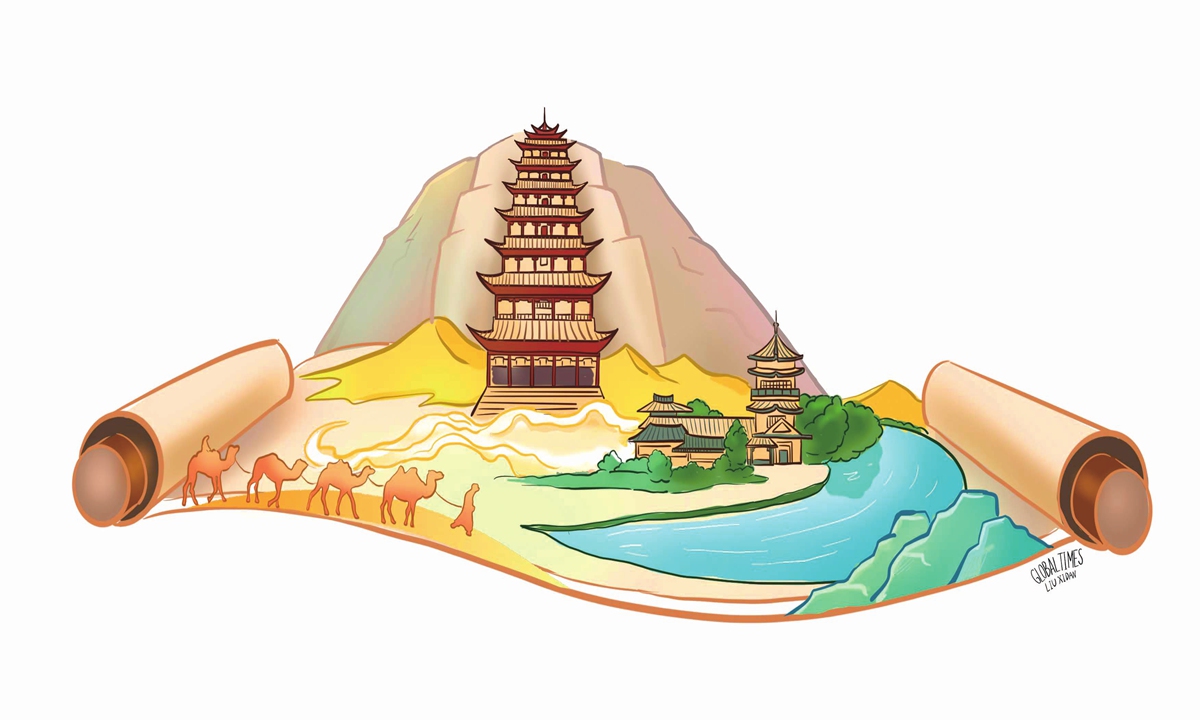
Illustration: Liu Xidan/Global Times
On June 13, 1907, Marc Aurel Stein, a British archaeologist and explorer, departed from the Mogao Caves in Dunhuang, Northwest China's Gansu Province, with more than 20 boxes of writings, paintings and other artifacts that were acquired through deceptive means.
During a recent trip to Dunhuang, I saw three lines of inscribed text on the wall of Cave 17 in the Yulin Caves, which, despite the passage of more than 100 years, still reads clearly, "Stein, British Prime Minister and Secretary of State for Education, traveled here."
Our guide told us that Stein, who previously worked for the Ministry of Education in the British Raj, contacted a British diplomat in China through a close friend and fabricated a high-ranking official title for him, so that Stein could gain access to China and facilitate his deceitful actions.
When the artifacts were transported to Britain and presented to European audiences, they caused quite a stir. China was once again "discovered" through these looted artifacts, a process that coincided with the colonial exploitation of China by Western powers since the Opium Wars.
But as the history of Dunhuang's "discovery" became known to the Chinese people, these feelings gradually became part of their understanding of China's relationship with the West, allowing them to see how the West perceived China and how the West's view of China was formed.
The Mogao Caves at Dunhuang are situated at a strategic point along the ancient Silk Road and at the intersection of trade routes as well as religious, cultural and intellectual influences.
The 492 cells and cave sanctuaries are renowned for their statues and wall paintings, which span 1,000 years of Buddhist art. In the surrounding areas of Dunhuang, numerous artifacts from various cultures have been discovered.
Alongside the rich cultural heritage and historical development of ancient China, the Dunhuang culture also incorporates influences from ancient Indian, Greek, and Persian civilizations, as well as various Central Asian peoples.
As I stroll through the Hexi Corridor today, whether walking amid ancient sites that have endured the test of time or standing in front of the artifacts curated in various museums, I increasingly appreciate the profoundness of Chinese culture. However, concurrently, a significant disparity exists between the perception and comprehension of China in the Western world and the actualities of China, encompassing its rich historical, cultural and traditional heritage.
In recent years, there has been a more profound and broader development of Chinese archaeological discoveries, research, and a particular focus on museum construction in this region. When these researches are more closely linked to the development of modern China, it greatly enriches the Chinese people's understanding of their own history and culture.
The profound Dunhuang culture results from long-term exchanges and integration of various civilizations. These were also part of the basic considerations that informed modern China's choice of development path.
Obviously, this information has not been effectively communicated to the world. As a result, many Westerners still perceive China based on outdated textbooks, or through the lens of stereotypes from the era of the "discovery of Dunhuang."
Why did the four great civilizations of the world converge and interact at Dunhuang in China? What kind of cultural spirit and mind-set does it embody? Only when these questions are clarified, can we understand the rise of China today and the significance of China's modernization and the Belt and Road Initiative for the world.
The author is a senior editor with the People's Daily, and currently a senior fellow with the Chongyang Institute for Financial Studies at Renmin University of China. dinggang@globaltimes.com.cn. Follow him on X @dinggangchina




